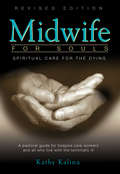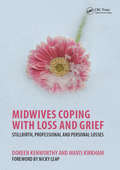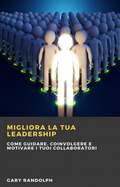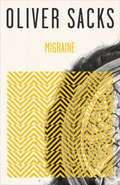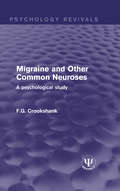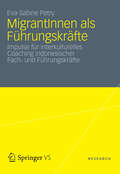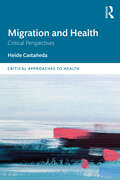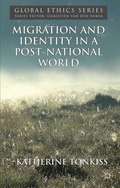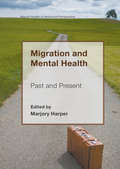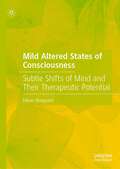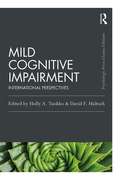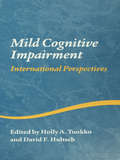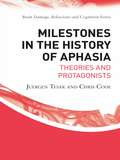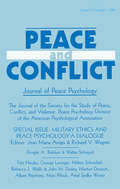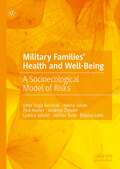- Table View
- List View
Midwife for Souls
by Kathy KalinaOftentimes caregivers, friends, and family are unsure of what to say and what to do to comfort the sick and the dying. Midwife for Souls provides specific Catholic insight and highlights the power of prayer as a guide. This best-selling book has been revised to include a new section of inspiring stories and lessons learned in hospice ministry.
Midwives Coping with Loss and Grief: Stillbirth, Professional and Personal Losses
by Doreen Kenworthy Mavis KirkhamThe experience of stillbirth and other losses in pregnancy at what is usually a time of great joy is tragic for everyone involved, including midwifery professionals. Although research increasingly shows how profound the effects of loss can be, few studies have explored the effects of pregnancy loss - which often leads to other personal and professional traumas such as loss of autonomy or a workplace - on midwives. This in-depth investigation uses a phenomenological approach to capture midwives' experiences of loss and grief in their own words, and encompasses both pregnancy loss and wider professional and personal issues. It then makes recommendations to enhance midwives' resilience and ability to cope appropriately, whilst giving maximum support to their clients. Reflections on the emerging implications for midwifery education and practice further broaden the scope of the analysis. The insights in this book will be of great use to midwifery managers and supervisors. They will also help midwives to nurture themselves, their colleagues and their clients at a time when pressures on the service can leave support lacking. The devastating experience of losing a baby for women and their families is something that, as midwives, we strive to understand in order to provide appropriate practical and emotional support. Doreen and Mavis encourage us to consider how we are affected by the grief of others at a deeply personal level. Ultimately the message in this book is one of hope: through reflection and the sharing of experiences midwives who have been with women whose babies have died can regain their personal strength and learn to re-shape memories in ways that contribute to personal growth and understanding.A" - From the Foreword by Nicky Leap
Miel y limón
by Elbeth Vicious«Y ahí, entre toda esa locura a medio camino entre lo salvaje y lo amable, me encuentro los ojos más bonitos del mundo.» Carla está harta. Harta de su trabajo, de su bloqueo creativo y de esa rutina que amenaza con asfixiarla a cada día que pasa. Harta de todo y de todos, excepto de ese delicioso pastel de limón que, cada martes y jueves, encarga a su restaurante favorito. Por eso, cuando introduce la mano en la bolsa de papel marrón y se encuentra con un estúpido e insulso pastel de miel, pierde la cabeza. Dispuesta a descargar toda su frustración con quien haya cometido ese terrible error, pone rumbo al restaurante. Sin embargo, al abrir la puerta, frente a una clase llena de mujeres (y un hombre) preparadas para aprender repostería, se topa con lo último que necesitaba en su vida: una fuerza de la naturaleza encerrada entre rizos y curvas llamada Ángela. Arrastrada por su energía, no tarda en convertirse en una alumna más. Y, por mucho que intente negarlo, el rencor comienza a transformarse en algo que Carla no sabe o no quiere identificar. Porque lo que Ángela y Carla sienten está muy claro para todos... excepto para ellas. Pero el amor no entiende de dudas ni miedos y parece decidido a cruzar sus caminos una y otra vez hasta que acepten que su destino está en brazos de la otra.
Migliora la tua leadership: Questo e-book tratta tematiche relative al miglioramento delle competenze di leadership
by Gary RandolphUn buon leader sa come motivare e organizzare il suo team. Diventare un buon leader richiede impegno e il cambiamento di una certa mentalità. Se saprai essere un buon leader, il tuo team ti seguirà con entusiasmo. Il tuo ruolo di leader influisce sul ruolo dei membri del tuo team e se avrai buone capacità di leadership, la performance dei tuoi collaboratori migliorerà. Se sei diventato un leader per la prima volta, hai bisogno di migliorare le tue competenze di leadership. Basandosi su ricerche specifiche, questo e-book ti spiegherà i principi fondamentali per diventare un buon leader. Questo e-book ti guiderà attraverso i seguenti step: - Come migliorare le capacità di leadership in ambito lavorativo - Come gestire le responsabilità - Diverse capacità di leadership - Imparare dalle critiche - Migliorare le tue competenze comunicative - Diventare un modello di ruolo - Come mantenere motivati i collaboratori - Sviluppare la passione per il proprio lavoro - Apprendere una corretta disciplina - Approccio positivo - Riconoscimento e ricompense - Provare nuove idee --> Vai all'inizio della pagina e fai clic su Aggiungi al carrello per acquistare subito questo e-book Disclaimer: L'autore e/o il detentore della proprietà intellettuale non compie alcuna rivendicazione né rilascia alcuna promessa o garanzia in merito all'accuratezza, completezza o adeguatezza dei contenuti di questo libro e declina espressamente la responsabilità su eventuali errori e omissioni nei contenuti proposti. Il prodotto si intende solo per uso referenziale. È consigliabile consultare un professionista prima di agire alla stregua di uno qualsiasi dei contenuti ivi presenti. Genere: PSICOLOGIA/personalità Genere secondario: AUTO-AIUTO /crescita personale/autostima Lingua: italiano
Migraine
by Oliver Sacks‘A mine of treasures, a source of visions, a microcosm of human experience and suffering, the philosopher’s stone: Migraineis a remarkable achievement’ Sunday Telegraph Migraine is an age-old – the first recorded instances date back over two thousand years – and often debilitating condition, affecting a ‘substantial minority’ of the population across the globe. In this book, Oliver Sacks offers at once a medical account of its occurrence and management; an exploration of its physical, physiological, and psychological underpinnings and consequences; and a meditation on the nature and experience of health and illness. ‘It delves into the workings of the brain with brilliant complexity, and should be required reading for migraine sufferers or those with an intellectual bent’ Cosmopolitan ‘Migraineis full of those wondrous insights that have made Oliver Sacks the most accessible and at the same time the most magisterial of doctors’ Anita Brookner, Spectator ‘Written with Sacks’s customary insight and grace, no book has helped me understand more about the mind-body connection’ Hilary Mantel, Mail on Sunday
Migraine
by Oliver SacksThe many manifestations of migraine can vary dramatically from one patient to another, even within the same patient at different times. Among the most compelling and perplexing of these symptoms are the strange visual hallucinations and distortions of space, time, and body image which migraineurs sometimes experience. Portrayals of these uncanny states have found their way into many works of art, from the heavenly visions of Hildegard von Bingen to Alice in Wonderland. Dr. Oliver Sacks argues that migraine cannot be understood simply as an illness, but must be viewed as a complex condition with a unique role to play in each individual's life.
Migraine and Other Common Neuroses: A Psychological Study (Psychology Revivals)
by F.G. CrookshankOriginally published in 1926, as part of the Psyche Miniatures Medical Series, this title is based on two lectures given to the North-East London Clinical Society and the North-East London Post Graduate College respectively. Francis Graham Crookshank was a British epidemiologist, and a medical and psychological writer. Today it can be read and enjoyed in its historical context.
MigrantInnen als Führungskräfte
by Eva-Sabine PetryInterkulturelles Coaching gilt als ideale Ergänzung zu interkulturellem Training für Expatriates. Ausländische Führungskräfte in Deutschland erhalten aber oft weder das eine noch das andere, sondern müssen sich selbst orientieren. Weltbild und Lernstil, die Migrationserfahrung und die asiatische Gewissensprägung spielen eine entscheidende Rolle in der Zusammenarbeit mit den oft hoch qualifizierten asiatischen MigrantInnen. Eva-Sabine Petry untersucht am Beispiel indonesischer Fach- und Führungskräfte, wie das westliche Konzept des Coaching adaptiert werden muss, damit es für MigrantInnen zur echten Unterstützung im Arbeitsalltag und bei der Übernahme von Führungsverantwortung wird. Sie zeigt darüber hinaus Wege zu gemeinsamem interkulturellen Lernen auf.
Migration and Health: Critical Perspectives (Critical Approaches to Health)
by Heide CastañedaMigration and Health: Critical Perspectives offers a radical rethinking of the field by unsettling conventional ideas of mobility and borders to highlight the ways in which they produce health inequalities. Covering a wide range of topics, the text provides insight through a critical lens, and proposes areas for intervention along with an added emphasis on the need for future research to address the health inequities that affect migrants. It illustrates how a critical perspective can deepen our understanding of the relationship between migration and health, which remains a defining global issue of our century. The text employs a critical approach to examine the structural conditions of inequality and larger historical and political processes, recognizing that exclusionary bordering practices increasingly occur away from physical points of entry. It posits the concept of migration as complex, tangled and multi-directional and underscores how migrant vulnerability can shape the lives of people in wider communities. Furthermore, it acknowledges diverse and intersectional standpoints, as well as shifting spatial and temporal influences. Chapters include coverage of health in transit; healthcare access and utilization; clinical encounters; communicable disease; labor and occupational health; gender and sexuality; immigration enforcement, detention, deportation; and the effects of forced displacement on refugee and asylum-seeker health. The text is useful for students and scholars of migration or health disparities seeking to understand how the two issues can be approached in a more holistic and critical way. It is further aimed at practitioners and policymakers who are interested in gaining familiarity with the structural conditions of inequality along with the larger historical and political processes that influence contemporary migration patterns.
Migration and Identity in a Post-National World
by Katherine TonkissKatherine Tonkiss offers a succinct account of constitutional patriotism theory, specifically arguing that it involves a commitment to free migration. She draws on qualitative research to explore the implications of this claim for the dynamics of post-national identity and belonging in local communities.
Migration and Intercultural Psychoanalysis: Unconscious Forces and Clinical Issues
by Kristin White Ina KlingenbergHow does migration affect us in the deeper layers of our minds, where forces are at work that affect our mental and physical health, our experiences in the world and our behaviour? This edited volume brings together contributions on the social, historical and personal aspects of migration from a psychoanalytic viewpoint. Clinical perspective is combined with a wider view that makes use of psychoanalytic concepts and experience to understand problematic issues around migration today. Later chapters take the historical background into account: the history of psychoanalysis itself is a history of migration, beginning with Freud’s experiences of migration, in particular his escape from Vienna to London at the end of his life, to answer questions regarding migration, refugees, living in a 'multicultural society' and living in a 'foreign culture'. Taking on the challenge of looking at the multi-layered, often subtle, yet powerful emotional and unconscious layers of meaning around migration, this book brings together practice and theory and will be of great interest to psychoanalysts, psychotherapists and those with an interest in the working of the mind in an intercultural context.
Migration and Mental Health
by Marjory HarperThe relationship between migration and mental health is controversial, contested, and pertinent. In a highly mobile world, where voluntary and enforced movements of population are increasing and likely to continue to grow, that relationship needs to be better understood, yet the terminology is often vague and the issues are wide-ranging. Getting to grips with them requires tools drawn from different disciplines and professions. Such a multidisciplinary approach is central to this book. Six historical studies are integrated with chapters by a theologian, geographer, anthropologist, social worker and psychiatrist to produce an evaluation that addresses key concepts and methodologies, and reflects practical involvement as well as academic scholarship. Ranging from the mid-nineteenth century to the present, the book explores the causes of mental breakdown among migrants; the psychological changes stemming from their struggles with challenging life circumstances; and changes in medical, political and public attitudes and responses in different eras and locations.
Migration, Diversity, and Education
by Fred Dervin Saija BenjaminThe concept of Third Culture Kids is often used to describe people who have spent their childhood on the move, living in many different countries and languages. This book examines the hype, relevance and myths surrounding the concept while also redefining it within a broader study of transnationality to demonstrate the variety of stories involved.
Mild Altered States of Consciousness: Subtle Shifts of Mind and Their Therapeutic Potential
by Eileen SheppardThis book draws on transpersonal anthropology and psychology in order to explore mild altered states of consciousness (ASCs) experienced in everyday life. While research into consciousness and particularly ASCs is growing, this book focuses on a neglected area: ‘everyday’ experiences of ASCs. Opening with an up-to-date overview of the development of the study of ASCs, the author presents an in-depth empirical exploration and mapping of mild ASCs. Dr Sheppard examines original research conducted in a range of religious and secular contexts with participants who were engaged in activities including prayer, sport, nature conservation, music and musical instrument making, and TV viewing. The author takes a novel phenomenological approach to the analysis of ASCs, emphasising the subjective experience. The book explores the healing potential of such mild ASCs; the everyday fantasy reality of the interior landscape; and discusses the problem of validity, and belief in the study of ASCs. It will appeal to students and scholars of transpersonal psychology, consciousness studies, social anthropology, and the philosophy of mind.
Mild Cognitive Impairment: International Perspectives (Psychology Press & Routledge Classic Editions)
by Holly A. Tuokko David F. HultschThe Classic Edition of this foundational text includes a new preface from Holly A. Tuokko, examining how the field of Mild Cognitive Impairment (MCI) has developed since first publication. Bringing together research from multiple studies and perspectives from various countries, the volume identifies MCI as an important clinical transition between normal aging and the early stages of Alzheimer's disease (AD). The up-to-date preface highlights the expansion in research, examining the benefits of various pharmacological, cognitive and behavioral approaches to intervention. Influenced by recent findings in neuroplasticity across the lifespan, the book recognizes the importance of intervention at the earliest stages of the decline trajectory. It revisits the contested diagnostic approaches for MCI as well as the varying prevalence of MCI internationally, yet points to the need for further longitudinal studies to fully understand the condition. Mild Cognitive Impairment continues to provide a comprehensive resource for clinicians, researchers and students involved in the study, diagnosis, treatment and rehabilitation of people with MCI.
Mild Cognitive Impairment: International Perspectives (Studies on Neuropsychology, Neurology and Cognition)
by Holly A. Tuokko David F. HultschMild Cognitive Impairment (MCI) has been identified as an important clinical transition between normal aging and the early stages of Alzheimer's disease (AD). Since treatments for AD are most likely to be most effective early in the course of the disease, MCI has become a topic of great importance and has been investigated in different populations of interest in many countries. This book brings together these differing perspectives on MCI for the first time. This volume provides a comprehensive resource for clinicians, researchers, and students involved in the study, diagnosis, treatment, and rehabilitation of people with MCI. Clinical investigators initially defined mild cognitive impairment (MCI) as a transitional condition between normal aging and the early stages of Alzheimer’s disease (AD). Because the prevalence of AD increases with age and very large numbers of older adults are affected worldwide, these clinicians saw a pressing need to identify AD as early as possible. It is at this very early stage in the disease course that treatments to slow the progress and control symptoms are likely to be most effective. Since the first introduction of MCI, research interest has grown exponentially, and the utility of the concept has been investigated from a variety of perspectives in different populations of interest (e.g., clinical samples, volunteers, population-based screening) in many different countries. Much variability in findings has resulted. Although it has been acknowledged that the differences observed between samples may be ‘legitimate variations’, there has been no attempt to understand what it is we have learned about MCI (i.e., common features and differences) from each of these perspectives. This book brings together information about MCI in different populations from around the world. Mild Cognitive Impairment will be an important resource for any clinician, researcher, or student involved in the study, detection, treatment, and rehabilitation of people with MCI.
Miles from Ordinary: A Novel
by Carol Lynch WilliamsThirteen-year-old Lacey wakes to a beautiful summer morning excited to begin her new job at the library, just as her mother is supposed to start work at the grocery store. Lacey hopes that her mother's ghosts have finally been laid to rest; after all, she seemsso much better these days, and they really do need the money. But as the hours tick by and memories come flooding back, a day full of hope spins terrifyingly out of control.
Milestones in the History of Aphasia: Theories and Protagonists (Brain, Behaviour and Cognition)
by Chris Code Juergen TesakMilestones in the History of Aphasia surveys the history of aphasia from its earliest mentions in ancient times, to the turn of the new millennium in 2000. The book takes a predominantly chronological approach starting with an examination of the earliest medical documents and medieval attempts to understand aphasia, to the momentous events of the Nineteenth and Twentieth Centuries, up to the development of modern cognitive neuroscience in recent years. It traces the development of theory about and understanding of aphasia, and the role of significant individuals in this history. The result is a well illustrated introduction to the main events and personalities in the rich history of aphasia. This accessible book provides a unique insight into the fascinating development of research in aphasia. It will be of great interest to undergraduates and postgraduates, researchers, teachers and clinicians in psychology, speech and language pathology and therapy, neurology and linguistics.
Milestones: Normal Speech and Language Development Across the Life Span
by John W. Oller Stephen D. Oller Linda C. BadonThis book provides an introduction to cutting-edge theory and research dealing not only with the development of speech forms but with the full range of sign systems that undergird normal speech and language development across the whole life span.
Military Adaptation in War
by Williamson MurrayMilitary Adaptation in War addresses one of the most persistent, yet rarely examined, problems that military organizations confront: namely, the problem of how to adapt under the trying, terrifying conditions of war. This work builds on the volume that Professor Williamson Murray edited with Allan Millett on military innovation (a quite different problem, though similar in some respects). In Clausewitzian terms, war is a contest, an interactive duel, which is of indeterminate length and presents a series of intractable problems at every level, from policy and strategy down to the tactical. Moreover, the fact that the enemy is adapting at the same time presents military organizations with an ever-changing set of conundrums that offer up no easy solutions. As the British general, James Wolfe, suggested before Quebec: "War is an option of difficulties. " Dr. Murray provides an in-depth analysis of the problems that military forces confront in adapting to these difficulties.
Military Deployment and its Consequences for Families
by Shelley Macdermid Wadsworth David S. RiggsWar-related separations challenge families in many ways. The worry and uncertainty associated with combat deployments provokes anxiety in family members left at home. Lengthy separations may challenge the personal, social, and economic coping resources of families at home. In this war, thanks to medical advances, many service members who previously would have died of their injuries are returning home to live long, although altered lives. As a result, families are facing the additional challenge of assisting service members who have experienced amputation, traumatic brain injury, and psychological wounds. These challenges are faced not only by service members in the active component of the armed forces, but also by service members in the National Guard and Reserves. In response, the Department of Defense has launched unprecedented efforts to support service members and families before, during and after deployment in all locations of the country as well as in remote locations. These support efforts are focused not only on medical care, but also mental health care and logistical support. Research about families and war tends to move forward in fits and starts associated with major conflicts, and there is currently an increasing flow of family research moving into the scientific domain. Military Families and the Aftermath of Deployment focuses heavily on the aftermath of deployment for families. It is the first compilation of such chapters released in relation to the wars in Iraq and Afghanistan, and includes contributions from leading researchers from diverse disciplines and arenas, including universities, the Veterans Administration, and the Department of Defense, as well as international researchers from Canada, and Croatia, among others. This work will be of use to graduate students and researchers in family studies, social work, counseling, military science, psychology and sociology.
Military Ethics and Peace Psychology: A Dialogue:a Special Issue of peace and Conflict
by Jean Maria Arrigo Richard V. WagnerFirst published in 2005. Routledge is an imprint of Taylor & Francis, an informa company.
Military Families' Health and Well-Being: A Socioecological Model of Risks
by Janja Vuga Beršnak Jelena Juvan Živa Humer Andreja Živoder Ljubica Jelušič Alenka Švab Bojana LobeThis book examines military families' well-being and health outcomes by providing a critical theoretical perspective on their position and the risks and challenges affecting them. Authors explore the tension between demands made by two greedy institutions—the military and the family—and how the well-being of families is negotiated between the two. Uniquely, the book employs an integrative approach to observing and analyzing military-specific risk and protective factors for health outcomes of military families on various social-ecological levels, including relationship satisfaction and dissatisfaction, intimate partnership violence, parent-child relationships, child well-being, psychoactive substance abuse, depression, and PTSD. Throughout the chapters, the authors analyze research findings that reveal new health outcomes and present an empirically-tested model of military-specific risk and protective factors.
Military Past, Civilian Present: International Perspectives on Veterans' Transition from the Armed Forces (International Perspectives on Social Policy, Administration, and Practice)
by Paul Taylor Emma Murray Katherine AlbertsonThis edited book presents a synthesis of current international knowledge on the topic of military veteran transition to civilian life. Understanding the transition of individuals from military institutions to civilian life is of great importance. The essential elements of transition support are currently widely debated in order to assess current practice and potential shortcomings in the intention to improve health, welfare and social outcomes for military veterans. This text links original research and critical commentary to public policy and practice in the area of veteran transition. Doing so through a collection of international perspectives assists in locating continuity and difference between strategies, agendas and the realities of what is actually known of the veteran’s experience. Chapters in this text examine the subject of transition along lines of enquiry that focus in on themes such as social justice, veteran identity and developments in transition agendas. Globally, many veterans face complex social issues such as low income, barriers to employment, and problems of health and welfare. Chapters take stock of the real-world issues affecting veterans and at the same time casts a critical eye over the limitations in accessing, or denial of access to opportunities, support and remedy. The veteran identity is an important dimension of enquiry here. This book looks at the relational factors between the veteran and the public, the creation of a master status and the challenges faced by veterans in transitioning into a cultural context that is saturated with imagery of what a veteran ‘is’. Chapters also seek to pose recommendations as to how the policy and practice agenda that surrounds veterans and the bridging of the gap between military and civilian life may be developed. Here authors point towards the value of knowledge, research and analysis that is underpinned by participatory strategies with veterans themselves. For example, seeking to establish lines of enquiry that value the voice of veterans as an ongoing and iterative dimension of developing understanding.
Military Psychologists' Desk Reference
by Bret A. Moore Jeffrey E. BarnettMilitary Psychologists' Desk Reference is the authoritative guide in the field of military mental health, covering in a clear and concise manner the depth and breadth of this expanding area at a pivotal and relevant time.
